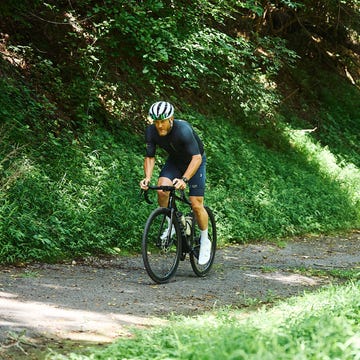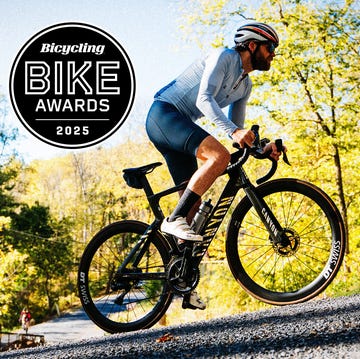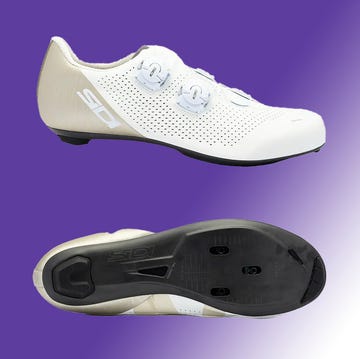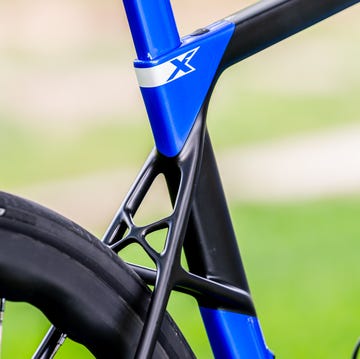Say what you will about Colnago’s latest aero bike—but you certainly can’t call it boring.
As all-around road racing bikes proliferated through the peloton over the last few seasons, many brands landed on similar aero designs. Features like dropped seat stays, truncated aero-foil shapes, and sloped top tubes are so omnipresent that many road race bikes look almost undistinguishable without paint and logos. For example, Colnago’s all-around racing bike, the V4Rs—raced by Tadej Pogačar to win the 2024 Tour de France, Giro d’Italia, and World Championships—uses every one of these design elements.
A New Silhouette
While Colnago’s Y1Rs is aesthetically polarizing (to put it mildly), it’s at least bringing some new shapes—and a radical silhouette—to road cycling. The bike’s front end features a Y-shaped handlebar that evokes the front wing of a Formula-1 car (or the Cervelo S5).
Colnago combines the bar with a bayonet-style fork to achieve a massive 19% (claimed) reduction in frontal area compared to the V4Rs. This type of fork design also allows Colnago to extend the headtube forward, improving the airflow around the bike’s leading edge. The downtube’s shape variably hugs the front wheel and features some proprietary bottle cages that (thankfully) are designed around standard round bottles.
The second half of the bike is where things get wild—and potentially enter a gray area in the UCI rules. According to Colnago, the unconventional seat tube, top tube, and chainstay junction resulted from its “pursuit of greater aerodynamic performance in a critical area for airflow.” The Italian brand took advantage of a UCI rule that says the seatpost can be placed anywhere along the top tube. This rule is on page 24 of the UCI’s Clarification of Technical Regulations document.
Essentially, the top tube of the Y1Rs starts at the headtube, bends where the seatpost enters the frame, and ends at the seat stay junction. It also features a very short seat tube that primarily shields the rear wheel from the wind.
This design has the added benefit of completely decoupling the seatpost from the rigid structure of the rest of the frame. This allows it to be placed at a highly slack angle creating added flex and supposedly a significant boost in rider comfort. Colnago dubs this shape “Defy”.
How the Y1Rs Compare to Other WorldTour Bikes
Colnago claims some impressive and scary aero benefits (if you have to race against Tadej Pogačar). At 31 mph (or 50 kph), the Y1Rs is 20 watts faster than the V4Rs in a perfect headwind. If you take the average saved over the V4Rs over a full yaw sweep of -15 degrees to +15 degrees, it is 25 watts faster. These numbers will surely cause many teams consternation, given how dominant Pogačar was in 2024 with his long-distance attacks.
If Colnago’s numbers are believed, it performs quite well against other bikes in the field. At zero yaw angle, the Y1Rs is a single watt faster than its best competitor, but the Colnago averages eight watts faster at the full sweep.
Given the anonymity of the “best competitor” stand-in, we were initially skeptical of these numbers. But when we pressed Davide Fumagalli, head of road bike development at Colnago, on the specifics, he told us that they had tested many different WorldTour race bikes, and the numbers for the “best competitor” were a combination of taking the best bike at each yaw angle. So essentially, Colnago created a fictional bike that tested fastest at every wind angle and then designed the Y1Rs to be faster still.
Although what you see on the outside is striking, we also learned several interesting details about the development of this bike from Fumagalli.
➡️ Colnago performed extensive testing to ensure a correlation between its CFD software and wind tunnel data. CFD (computational fluid dynamics) is software that can predict the real-world aerodynamic performance of a bicycle. But if the CFD model isn’t accurate, the predicted results won’t match the wind tunnel.
Colnago built a full-size bike and equipped it with 70 pressure sensors. The bike was then run in the wind tunnel and collected heaps of data. After crunching this data, the engineers used the results to fine-tune the CFD model in their software.
Colnago claims its CFD model is now twice as accurate as the standard model in the software used by other cycling brands. This more accurate model not only aided the development of the Y1Rs but will also help optimize the design of future Colnago bikes.
➡️ The downtube bottle cage assembly doubles as the holder for the Di2 battery. With the turn of a few screws, the battery can be accessed and replaced in two minutes. Fumagalli stated that the mechanics of Colnago’s sponsored teams mandated the two-minute change so a battery could be swapped on the roadside in the middle of a race.
➡️ The Y1Rs would be even faster with aero water bottles. Fumagalli stated that Colnago even prototyped aero bottles for the Y1Rs—with unique shapes for each location—but UAE Team Emirates vetoed that idea. The team said the aero bottles are harder to grab from a car, other riders, or from soigneur at the side of the road. Additionally, the team stated they needed universal bottles in case riders swap to the V4Rs in the middle of a stage.
Fumagalli also mentioned an interaction with one of the UAE riders who said that, particularly on mountain stages, the riders have one bottle filled with water and the other filled with drink mix and, depending on where they are in the stage, they’ll they will swap the bottles around in the cages. An action the specially designed seat and down tube bottles would not allow.
➡️ Another interesting aero tidbit we learned from Fumagalli revolves around wheels and their role in frame design.
In the recent past, some bike brands often told us that the aerodynamics of a spinning wheel interacted with the frame so much that they optimized their bikes’ aerodynamics around a specific wheelset (and often developed wheelsets concurrently with frames).
When asked if the Y1RS was developed explicitly around the Enve ENVE SES 4.5 favored by Tadaj Pogačar and UAE Team Emirates, Fumagalli said that while a lot of the Y1Rs’ wind tunnel testing was performed with the 4.5, the Y1Rs was not developed with this wheelset in mind.
Fumagalli stated it wasn’t necessary to optimize the Y1Rs around the 4.5, or any wheelset because wide-set fork legs and stays don’t aerodynamically interact as much with a spinning wheel as narrower-set legs and stays. As a result, wide-stance bikes like the Y1Rs are wheelset agnostic. They get faster with faster wheels and slower with slower wheels, but there’s no advantage to using any specific wheel with the bike.
➡️ Unsurprisingly, the aero benefits come at a cost in the form of weight. Compared to the V4Rs, the Y1Rs adds 242 grams (or 0.53 pounds). This means that, at least for the foreseeable future, riders of UAE Team Emirates and UAE Team ADQ squads will still opt for the V4Rs when weight is a concern.
➡️ As futuristic as the Y1Rs is, Colango employs the comparatively ancient BSA bottom bracket standard. This is despite Colnago debuting ThreadFit 82.5 (also known as T45) in 2014, a prescient precursor to T47. Fumagalli explained that because of the additional weight of the Y1Rs’ aero design, they were looking to save grams wherever they could, and BSA is the lightest threaded BB standard.
How Does the Y1Rs Ride?
We have yet to swing a leg over the Y1Rs, so we cannot comment on the new bike’s ride quality or speed on the road.
We haven’t received US dollar pricing from Colnago on the new bike. However, the least expensive build features SRAM Red AXS and Vison Metron wheels for €12,300 (approx. $13,000). A team-level build with Shimano Dura-Ace and Enve’s SES 4.5 wheels is €16,200 (approx. $17,100). And since it’s Colnago, a top-range model with Campagnolo Super Record Wireless and Bora Ultra WTO is offered for €16,500 (approx. $17,400).
The Y1Rs Is a Welcome Sight
The road race bike market has stagnated. Other than logos, the bikes used for professional racing are virtually indistinguishable from each other, and, in turn, the road bikes on shop floors are also nearly indistinguishable clones.
And the bikes don’t simply look the same. In our testing, many WorldTour-level road race bikes perform similarly, with only nuanced differences around the edges. The bikes have geometry within millimeters, similar weight and stiffness figures, and vanishingly small aerodynamic differences.
That changed when Colnago dropped the Y1Rs. It looks like no other bike in the peloton and we are overjoyed that it exists.
Essentially, this bike was made for riders competing against the world’s best, in the world’s premier races—and who are physically capable of going bananas-fast. And by bananas, we mean six watts per kg FTP, 50 km/h on the flats, and 25km/h up the climbs.
The Y1Rs looks like it does (and why it is so fast) due to changes to the UCI equipment regulations that came into effect in 2023. With relaxed rules, engineers can be more daring. This means more creativity and diversity: Faster bikes and more interesting bikes.
We expect the Y1Rs to be the first of many new, radical-looking aero bikes. And we also expect unique-looking bikes from different brands as they seek to create the fastest bike possible within the new rules.
But assuming the UCI doesn’t roll back or implement new “interpretations” of its rules, brands will, again, coalesce around similar designs as they figure out how to extract maximum performance from the current ruleset. But that won’t happen for a while. And, hopefully, the UCI will update its “formula” more quickly than last time so race bikes don’t stagnate again.
The Y1Rs is not pretty or graceful—Colnago makes bikes like the Steelnovo and C68 for people who want conventionally attractive bikes. The Y1Rs looks like an engineering project because it is one. And Colnago made it specifically to help its best racers achieve their maximum potential.
Test Editor Dan Chabanov got his start in cycling as a New York City bike messenger but quickly found his way into road and cyclocross racing, competing in professional cyclocross races from 2009 to 2019 and winning a Master’s National Championship title in 2018. Prior to joining Bicycling in 2021, Dan worked as part of the race organization for the Red Hook Crit, as a coach with EnduranceWERX, as well as a freelance writer and photographer.

A gear editor for his entire career, Matt’s journey to becoming a leading cycling tech journalist started in 1995, and he’s been at it ever since; likely riding more cycling equipment than anyone on the planet along the way. Previous to his time with Bicycling, Matt worked in bike shops as a service manager, mechanic, and sales person. Based in Durango, Colorado, he enjoys riding and testing any and all kinds of bikes, so you’re just as likely to see him on a road bike dressed in Lycra at a Tuesday night worlds ride as you are to find him dressed in a full face helmet and pads riding a bike park on an enduro bike. He doesn’t race often, but he’s game for anything; having entered road races, criteriums, trials competitions, dual slalom, downhill races, enduros, stage races, short track, time trials, and gran fondos. Next up on his to-do list: a multi day bikepacking trip, and an e-bike race.
























